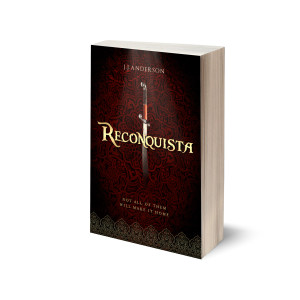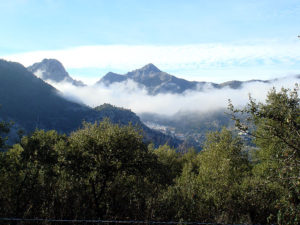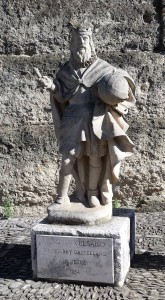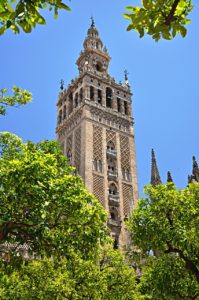Every story has a beginning, a middle and an end ( Aristotle’s protasis, epitasis and catastrophe if memory serves*, in a very loose translation ). So does the story I am writing, but mine is complicated by being spread over two books – ‘Reconquista‘ and its sequel – and each of these also has a beginning, a middle and an end.
catastrophe if memory serves*, in a very loose translation ). So does the story I am writing, but mine is complicated by being spread over two books – ‘Reconquista‘ and its sequel – and each of these also has a beginning, a middle and an end.
So, although there was a suitable end to ‘Reconquista‘, there were also unresolved plot lines. At one level, therefore, much of what must happen in the sequel has already been decided ( although how each element is resolved is another matter ). Warning! If you haven’t read ‘Reconquista‘ what follows gives away some of its plot.
 An example is, what happens to Don Reza? At the end of the first book he is, we assume, still held captive in the mountains and Atta is desperate to rescue him. So one plot element must address this. We already know, from what the cavalry lieutenant says to Nathan and Senor Thomas after their meeting with the King, that he has been ordered to tackle the bandits. Logically then, this is a major
An example is, what happens to Don Reza? At the end of the first book he is, we assume, still held captive in the mountains and Atta is desperate to rescue him. So one plot element must address this. We already know, from what the cavalry lieutenant says to Nathan and Senor Thomas after their meeting with the King, that he has been ordered to tackle the bandits. Logically then, this is a major  driver of plot and any ‘rescue attempt’ is likely to involve a number of our main characters, and quite a lot of jeopardy.
driver of plot and any ‘rescue attempt’ is likely to involve a number of our main characters, and quite a lot of jeopardy.
Similarly, we left Nathan living with the galley slaves, we don’t know what he’ll decide to do next. Will he return home? If he does, what sort of reception will he receive from his father? If he doesn’t, what will he do? This is the most open-ended of the unresolved issues at the end of book one.
The other cliff hanger is, of course, Rebecca’s answer to Ben’s proposal. This is the element which I am asked about most often. Does she accept him? I am not going to tell. Sorry, you’ll have to read the next book to find out.
In addition, however, to these existing plot drivers there is also the historical situation to take into account, because this is an historical novel and includes real events. This is likely to generate plot.
 Once King Alfonso X was re-established in Jerez we know that he expelled its Moorish inhabitants and granted much of their property to his own followers. The ‘Repartamiento’, a document drawn up at Alfonso’s behest, tells us how the property was distributed, to knights and to their followers in turn. So the city is very different in the sequel, both physically, given the reconstruction after the bombardment, and in terms of its inhabitants.
Once King Alfonso X was re-established in Jerez we know that he expelled its Moorish inhabitants and granted much of their property to his own followers. The ‘Repartamiento’, a document drawn up at Alfonso’s behest, tells us how the property was distributed, to knights and to their followers in turn. So the city is very different in the sequel, both physically, given the reconstruction after the bombardment, and in terms of its inhabitants.
This would be evident to the characters and must be factored into the story. How is Atta going to feel now, as one of the few Moors in Jerez? And how might he react? This could be a plot generator. The changing circumstances are also an opportunity to introduce some new and interesting characters to add to those we already know.
By early spring 1265 King Alfonso was in Seville, ( see Giralda, below right, which would have been there at that time, just without the bell tower on top ) where he set about raising troops and money for a full- scale assault on the Emirate of Granada. The Emir also began gathering forces, from the Arab countries to the south, so both were preparing for a possible war. Both rulers considered themselves to be men of honour, both, at this point, considered the other was planning to attack. A dangerous situation for the emissary of the Emir and his nephew in Jerez then, but also a chance for them to take part in real and important events.
scale assault on the Emirate of Granada. The Emir also began gathering forces, from the Arab countries to the south, so both were preparing for a possible war. Both rulers considered themselves to be men of honour, both, at this point, considered the other was planning to attack. A dangerous situation for the emissary of the Emir and his nephew in Jerez then, but also a chance for them to take part in real and important events.
So, when I take all these factors into consideration, I find that the plot of my sequel pretty much writes itself ( although there are some surprises too, as you might expect, which are new plot strands ). I, however, have to write the actual words, so I’ll be ploughing on.
*From Artistotles’ ‘Poetics‘ ( though not the fictional version created by Umberto Eco in ‘The Name of the Rose‘ ).
The next post in this short series will discuss character arcs. If you enjoyed reading this article you might also enjoy The journey continues The High Sierras Tormentas Once more with feeling


 RSS – Posts
RSS – Posts
2 responses to “Plotting”